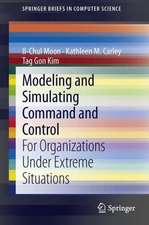Theory of Modeling and Simulation
Autor Bernard P. Zeigler, Herbert Praehofer, Tag Gon Kimen Limba Engleză Hardback – 18 ian 2000
- Presents a working foundation necessary for compliance with High Level Architecture (HLA) standards
- Provides a comprehensive framework for continuous and discrete event modeling and simulation
- Explores the mathematical foundation of simulation modeling
- Discusses system morphisms for model abstraction and simplification
- Presents a new approach to discrete event simulation of continuous processes
- Includes parallel and distributed simulation of discrete event models
- Presents a concept to achieve simulator interoperability in the form of the DEVS-Bus
Preț: 779.74 lei
Preț vechi: 1068.13 lei
-27% Nou
Puncte Express: 1170
Preț estimativ în valută:
149.22€ • 155.21$ • 123.19£
149.22€ • 155.21$ • 123.19£
Carte tipărită la comandă
Livrare economică 15-29 aprilie
Preluare comenzi: 021 569.72.76
Specificații
ISBN-13: 9780127784557
ISBN-10: 0127784551
Pagini: 536
Ilustrații: Illustrations
Dimensiuni: 178 x 254 x 36 mm
Greutate: 1.23 kg
Ediția:2 Rev ed.
Editura: Elsevier
ISBN-10: 0127784551
Pagini: 536
Ilustrații: Illustrations
Dimensiuni: 178 x 254 x 36 mm
Greutate: 1.23 kg
Ediția:2 Rev ed.
Editura: Elsevier
Public țintă
Senior undergraduate and graduate courses in departments of electrical engineering, systems science, and computer engineering. Professional engineers in the following areas, control, system engineering, system theory, modeling and simulation, and computer science.Cuprins
Part I: Basics.
Introduction to Systems Modeling Concepts.
Framework for Modeling and Simulation.
Modeling Formalisms and Their Simulators.
Introduction to Discrete Event System Specifications (DEVS).
Hierarchy of System Specifications.
Part II: Modeling Formalisms and Simulation Algorithms.
Basic Formalisms: DEVS, DTSS, DESS.
Basic Formalisms: Coupled Multicomponent Systems.
Simulators for Basic Formalisms.
Multiformalism Modeling and Simulation.
DEVS-Based Extended Formalisms.
Parallel and Distributed Discrete Event Simulation.
Part III: System Morphisms: Abstraction, Representation, Approximation.
Hierarchy of System Morphisms.
Abstraction: Constructing Model Families.
Verification, Validation, Approximate Morphisms: Living with Error.
DEVS and DEVS-like Systems: Universality and Uniqueness.
DEVS Representation of Systems.
Part IV: System Design and Modeling and Simulation Environments.
DEVS-Based Design Methodology.
System Entity Structure/Model Base Framework.
Collaboration and the Future.
Introduction to Systems Modeling Concepts.
Framework for Modeling and Simulation.
Modeling Formalisms and Their Simulators.
Introduction to Discrete Event System Specifications (DEVS).
Hierarchy of System Specifications.
Part II: Modeling Formalisms and Simulation Algorithms.
Basic Formalisms: DEVS, DTSS, DESS.
Basic Formalisms: Coupled Multicomponent Systems.
Simulators for Basic Formalisms.
Multiformalism Modeling and Simulation.
DEVS-Based Extended Formalisms.
Parallel and Distributed Discrete Event Simulation.
Part III: System Morphisms: Abstraction, Representation, Approximation.
Hierarchy of System Morphisms.
Abstraction: Constructing Model Families.
Verification, Validation, Approximate Morphisms: Living with Error.
DEVS and DEVS-like Systems: Universality and Uniqueness.
DEVS Representation of Systems.
Part IV: System Design and Modeling and Simulation Environments.
DEVS-Based Design Methodology.
System Entity Structure/Model Base Framework.
Collaboration and the Future.
Recenzii
From Book News, Inc.
"In addition to students of general and mathematical systems theory or of computer and information sciences, Zeigler (electrical and computer engineering, U. of Arizona) argues that students of any science and of business also benefit from knowing the theory of modeling. For students with a solid background in mathematics at the graduate or senior undergraduate level, he constructs a framework in which the concepts can be sketched in abstract forms and embodied in concrete modeling situations to further illuminate them. The first edition was published by Wiley Interscience in 1976; the second has been almost totally rewritten, for which task Zeigler has conscripted Herbert Praehoffer (systems science, Johannes Kepler U., Linz, Austria) and Tag Gon Kim (electrical engineering, Korea Advanced Institute of Science and Technology, Taejon)" --Book News, Inc.®, Portland, OR
"In addition to students of general and mathematical systems theory or of computer and information sciences, Zeigler (electrical and computer engineering, U. of Arizona) argues that students of any science and of business also benefit from knowing the theory of modeling. For students with a solid background in mathematics at the graduate or senior undergraduate level, he constructs a framework in which the concepts can be sketched in abstract forms and embodied in concrete modeling situations to further illuminate them. The first edition was published by Wiley Interscience in 1976; the second has been almost totally rewritten, for which task Zeigler has conscripted Herbert Praehoffer (systems science, Johannes Kepler U., Linz, Austria) and Tag Gon Kim (electrical engineering, Korea Advanced Institute of Science and Technology, Taejon)" --Book News, Inc.®, Portland, OR




























